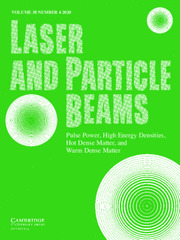Article contents
Diffraction and transport in dense plasmas: Especially liquid metals
Published online by Cambridge University Press: 16 October 2009
Abstract
Recent computer experiments on liquid Mg and Bi (and also on dense hydrogen) have focussed anew on issues involving static and dynamical structure in plasmas. In Mg and Bi, under normal liquid metal conditions, separation of core and valence electrons is valuable both for thermodynamics and in interpreting diffraction experiments. Mg is considered in some detail as a specific example where there is weak electron–ion interaction. Finally, dynamical structure is considered. After a brief summary relating back to the electron–electron pair correlation contribution in X-ray scattering, attention is next focussed on the (longitudinal) viscosity of alkali metals via the Kubo formula. This viscosity is shown to be dominated by ion–ion interactions. Nevertheless, an intimate relation at the melting point is exposed between shear viscosity, thermal conductivity, and electrical resistivity, the latter two transport coefficients being dominated by electrons.
- Type
- Research Article
- Information
- Laser and Particle Beams , Volume 16 , Issue 1: Special Issue: 24th ECLIM , March 1998 , pp. 71 - 81
- Copyright
- Copyright © Cambridge University Press 1998
References
- 3
- Cited by


